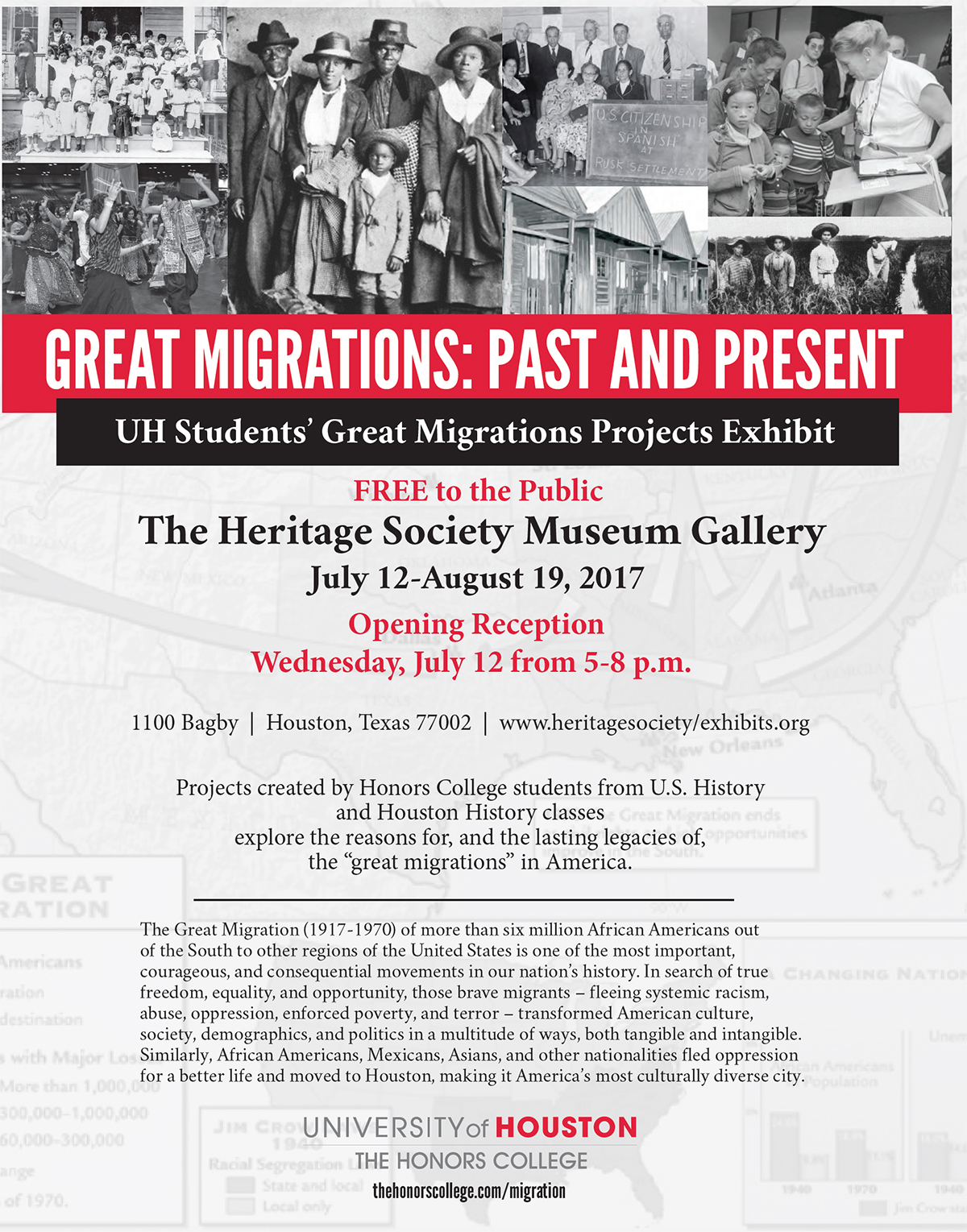
At the end of the 2017 spring semester, the University of Houston Honors College American History and Houston History students created artistic, literary, film, computer, and music projects focused on the largely unrecognized Great Migration and patterns of migration and immigration to Houston. Projects from both classes are on display in the exhibit Great Migrations: Past and Present at The Heritage Society at Sam Houston Park from July 12 to August 19, 2017.
Honors College assistant professor Dr. Irene Guenther’s modern U.S. History classes examined in-depth the Great Migration (1917-1970), both as it occurred and its current consequences and manifestations.
"We cannot fully understand our nation’s history without delving deeply into the fraught issue of race, yet most students enter my course uniformed about the oppression and violence African Americans endured in the decades between the end of the Civil War and the peak of the Civil Rights Movement," said Guenther. "My students read in-depth about segregation ‘by law’ and ‘by fact’ (by accepted social practices); learn how such inequality touched every crucial aspect of American life; and examine through research papers and creative educational projects how the major waves of the Great Migration changed our country in ways that still enrich and impact us today."
Dr. Debbie Z. Harwell, editor of Houston History in the Center for Public History and adjunct professor in the Honors College, had Houston History students incorporate the local with the national focus from the mid-nineteenth century to the present.
"Houston has grown from a mud hole on the bayou to a world energy capital with the nation’s most culturally diverse population," said Harwell. "That transition is the story of hundreds of thousands of people who migrated and immigrated here, making Houston their home, building the city on the backs of their labor, and creating a distinctly Houston culture."
These deeply researched creative projects inform us about the numerous reasons for – and the lasting legacies of – the Great Migration and the dramatic growth of Houston’s ethnic communities. Through their study, students come to understand the roots of movements such as Black Lives Matter and organizations like the Equal Justice Initiative, which remind us that while work still needs to be done, everyone benefits from the rewards that inclusiveness offers. Houston’s multi-ethnic, multi-racial society serves as a touchstone of what is possible.
The Great Migration of more than six million African Americans out of the rural South to other regions of the United States, including 44,000 who came to Houston, is one of the most important, courageous, and consequential movements in our nation’s history. In search of true freedom, equality, and opportunity, those brave migrants – fleeing systemic racism, abuse, oppression, enforced poverty, and terror – transformed American culture, society, demographics, and politics in a multitude of ways. As they arrived in their destination cities – Houston, Chicago, Baltimore, New York City, Detroit, Philadelphia, Los Angeles, Oakland, St. Louis, and Omaha, among others – African American migrants found themselves facing different forms of oppression, segregation, and violence, a caste system “by fact” rather than “by law.” Nonetheless, as they migrated, they brought with them their music, food, and faith, their talents, and their belief that they, too, deserved the full rights and equality of citizenship delineated in the Constitution.
Similarly, the influx of migrants and immigrants lured by the possibility of a better life has made Houston the most demographically and culturally diverse city in the United States. The study of African American, Mexican American, and Asian American immigration patterns highlights the factors that pushed them to leave their homes, such as discrimination, violence, poverty, and political unrest, alongside the factors that pulled them to Houston, especially jobs, educational opportunity, and increased freedom. As with the Great Migration nationally, these individuals who came from the rural South and a host of other countries have made their mark on Houston’s social, cultural, economic, political, and neighborhood histories; the city’s explosive growth; and attitudes about racial and ethnic inclusiveness.
"We hope that by placing the pieces in the museum for an extended period, they will reach a broader audience, giving the students’ interpretations of these historic events a greater voice," said Harwell.
The exhibit Great Migrations: Past and Present will be at The Heritage Society at Sam Houston Park, 1100 Bagby, Houston 77002. Hours are 10:00 a.m. to 4:00 p.m. Tuesday to Saturday. Limited free parking is available. For a map visit, http://www.heritagesociety.org/campu-map/.
For more information on the exhibit, please visit The Heritage Society website, http://www.heritagesociety.org/exhibits/ or The UH Honors College website, http://www.uh.edu/honors/about/news-events/greatmigration2017.php
See the Center for Public History website for a pdf of this information. http://www.uh.edu/class/ctr-public-history/_images/02migration_flyer_2017.pdf
Date: July 12-August 19, 2017
Time: 10:00 a.m. to 4:00 P.M. (Tuesday-Saturday)
Place: The Heritage Society Museum Gallery